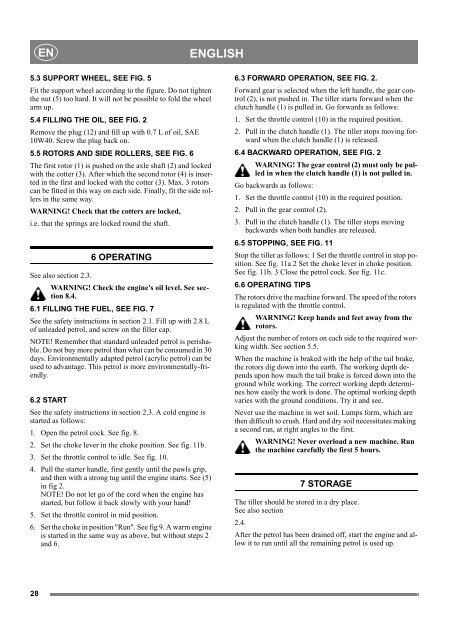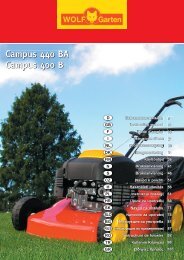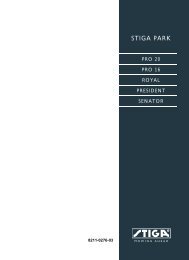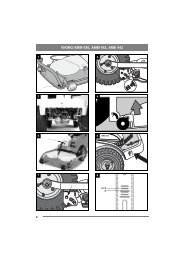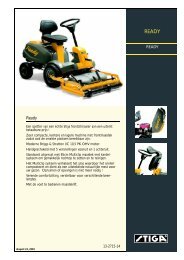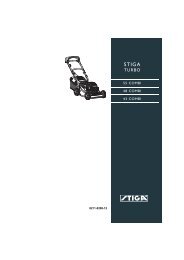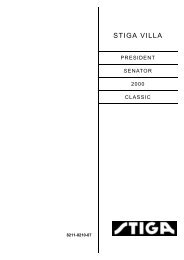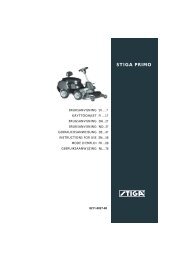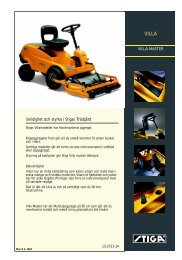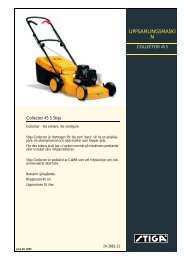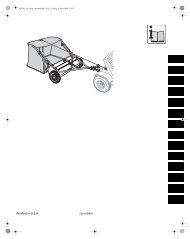JB 55
JB 55
JB 55
Create successful ePaper yourself
Turn your PDF publications into a flip-book with our unique Google optimized e-Paper software.
28<br />
EN<br />
5.3 SUPPORT WHEEL, SEE FIG. 5<br />
Fit the support wheel according to the figure. Do not tighten<br />
the nut (5) too hard. It will not be possible to fold the wheel<br />
arm up.<br />
5.4 FILLING THE OIL, SEE FIG. 2<br />
Remove the plug (12) and fill up with 0.7 L of oil, SAE<br />
10W40. Screw the plug back on.<br />
5.5 ROTORS AND SIDE ROLLERS, SEE FIG. 6<br />
The first rotor (1) is pushed on the axle shaft (2) and locked<br />
with the cotter (3). After which the second rotor (4) is inserted<br />
in the first and locked with the cotter (3). Max. 3 rotors<br />
can be fitted in this way on each side. Finally, fit the side rollers<br />
in the same way.<br />
WARNING! Check that the cotters are locked,<br />
i.e. that the springs are locked round the shaft.<br />
6 OPERATING<br />
See also section 2.3.<br />
WARNING! Check the engine's oil level. See section<br />
8.4.<br />
6.1 FILLING THE FUEL, SEE FIG. 7<br />
See the safety instructions in section 2.1. Fill up with 2.8 L<br />
of unleaded petrol, and screw on the filler cap.<br />
NOTE! Remember that standard unleaded petrol is perishable.<br />
Do not buy more petrol than what can be consumed in 30<br />
days. Environmentally adapted petrol (acrylic petrol) can be<br />
used to advantage. This petrol is more environmentally-friendly.<br />
6.2 START<br />
See the safety instructions in section 2.3. A cold engine is<br />
started as follows:<br />
1. Open the petrol cock. See fig. 8.<br />
2. Set the choke lever in the choke position. See fig. 11b.<br />
3. Set the throttle control to idle. See fig. 10.<br />
4. Pull the starter handle, first gently until the pawls grip,<br />
and then with a strong tug until the engine starts. See (5)<br />
in fig 2.<br />
NOTE! Do not let go of the cord when the engine has<br />
started, but follow it back slowly with your hand!<br />
5. Set the throttle control in mid position.<br />
6. Set the choke in position "Run". See fig 9. A warm engine<br />
is started in the same way as above, but without steps 2<br />
and 6.<br />
ENGLISH<br />
6.3 FORWARD OPERATION, SEE FIG. 2.<br />
Forward gear is selected when the left handle, the gear control<br />
(2), is not pushed in. The tiller starts forward when the<br />
clutch handle (1) is pulled in. Go forwards as follows:<br />
1. Set the throttle control (10) in the required position.<br />
2. Pull in the clutch handle (1). The tiller stops moving forward<br />
when the clutch handle (1) is released.<br />
6.4 BACKWARD OPERATION, SEE FIG. 2<br />
WARNING! The gear control (2) must only be pulled<br />
in when the clutch handle (1) is not pulled in.<br />
Go backwards as follows:<br />
1. Set the throttle control (10) in the required position.<br />
2. Pull in the gear control (2).<br />
3. Pull in the clutch handle (1). The tiller stops moving<br />
backwards when both handles are released.<br />
6.5 STOPPING, SEE FIG. 11<br />
Stop the tiller as follows: 1 Set the throttle control in stop position.<br />
See fig. 11a 2 Set the choke lever in choke position.<br />
See fig. 11b. 3 Close the petrol cock. See fig. 11c.<br />
6.6 OPERATING TIPS<br />
The rotors drive the machine forward. The speed of the rotors<br />
is regulated with the throttle control.<br />
WARNING! Keep hands and feet away from the<br />
rotors.<br />
Adjust the number of rotors on each side to the required working<br />
width. See section 5.5.<br />
When the machine is braked with the help of the tail brake,<br />
the rotors dig down into the earth. The working depth depends<br />
upon how much the tail brake is forced down into the<br />
ground while working. The correct working depth determines<br />
how easily the work is done. The optimal working depth<br />
varies with the ground conditions. Try it and see.<br />
Never use the machine in wet soil. Lumps form, which are<br />
then difficult to crush. Hard and dry soil necessitates making<br />
a second run, at right angles to the first.<br />
WARNING! Never overload a new machine. Run<br />
the machine carefully the first 5 hours.<br />
7 STORAGE<br />
The tiller should be stored in a dry place.<br />
See also section<br />
2.4.<br />
After the petrol has been drained off, start the engine and allow<br />
it to run until all the remaining petrol is used up.


